The Graphについて
Reading time: 6 min
このページでは、「The Graph」とは何か、どのようにして始めるのかを説明します。
グラフは、ブロックチェーン データのインデックス作成とクエリを行うための分散型プロトコルです。
のような複雑なスマートコントラクトを持つプロジェクトや、 のような NFT の取り組みでは、Ethereum のブロックチェーンにデータを保存しているため、基本的なデータ以外をブロックチェーンから直接読み取ることは実に困難です。
In the case of Bored Ape Yacht Club, we can perform basic read operations on like getting the owner of a certain Ape, getting the content URI of an Ape based on their ID, or the total supply. This can be done because these read operations are programmed directly into the smart contract. However, more advanced real-world queries and operations like aggregation, search, relationships, and non-trivial filtering are not possible. For example, if we wanted to query for Apes that are owned by a certain address and filter by one of its characteristics, we would not be able to get that information by interacting directly with the contract itself.
To get this data, you would have to process every single event ever emitted, read the metadata from IPFS using the Token ID and IPFS hash, and then aggregate it. It would take hours or even days for a decentralized application (dapp) running in a browser to get an answer to these simple questions.
独自のサーバーを構築し、そこでトランザクションを処理してデータベースに保存し、その上に API エンドポイントを構築してデータをクエリすることもできます。ただし、このオプションはであり、メンテナンスが必要であり、単一障害点が存在し、分散化に必要な重要なセキュリティ プロパティが壊れます。
ブロックチェーンデータのインデックス作成は非常に困難です。
Blockchain properties like finality, chain reorganizations, or uncled blocks complicate this process further. They make it time consuming and conceptually hard to retrieve correct query results from blockchain data.
The Graph provides a solution with a decentralized protocol that indexes and enables the efficient and high-performance querying of blockchain data. These APIs (indexed "subgraphs") can then be queried with a standard GraphQL API. Today, there is a hosted service as well as a decentralized protocol with the same capabilities. Both are backed by the open source implementation of .
The Graph は、サブグラフマニフェストと呼ばれるサブグラフ記述に基づいて、Ethereum のデータに何をどのようにインデックスするかを学習します。 サブグラフマニフェストは、そのサブグラフで注目すべきスマートコントラクト、注目すべきコントラクト内のイベント、イベントデータと The Graph がデータベースに格納するデータとのマッピング方法などを定義します。
サブグラフのマニフェストを書いたら、グラフの CLI を使ってその定義を IPFS に保存し、インデクサーにそのサブグラフのデータのインデックス作成を開始するように指示します。
この図では、サブグラフ・マニフェストがデプロイされた後のデータの流れについて、Ethereum のトランザクションを扱って詳しく説明しています。

フローは以下のステップに従います。
- Dapp は、スマート コントラクトのトランザクションを通じて Ethereum にデータを追加します。
- スマートコントラクトは、トランザクションの処理中に 1 つまたは複数のイベントを発行します。
- Graph Node は、Ethereum の新しいブロックと、それに含まれる自分のサブグラフのデータを継続的にスキャンします。
- Graph Node は、これらのブロックの中からあなたのサブグラフの Ethereum イベントを見つけ出し、あなたが提供したマッピングハンドラーを実行します。 マッピングとは、イーサリアムのイベントに対応して Graph Node が保存するデータエンティティを作成または更新する WASM モジュールのことです。
- Dapp は、ノードの を使用して、ブロックチェーンからインデックス付けされたデータをグラフ ノードに照会します。グラフ ノードは、ストアのインデックス作成機能を利用して、このデータを取得するために、GraphQL クエリを基盤となるデータ ストアのクエリに変換します。 dapp は、このデータをエンドユーザー向けの豊富な UI に表示し、エンドユーザーはそれを使用して Ethereum で新しいトランザクションを発行します。サイクルが繰り返されます。
The following sections provide more detail on how to define subgraphs, how to deploy them, and how to query data from the indexes that Graph Node builds.
Before you start writing your own subgraph, you might want to have a look at and explore some of the subgraphs that have already been deployed. The page for each subgraph contains a playground that lets you query that subgraph's data with GraphQL.